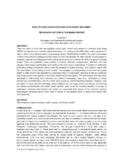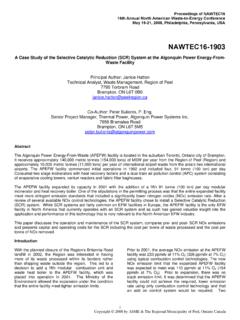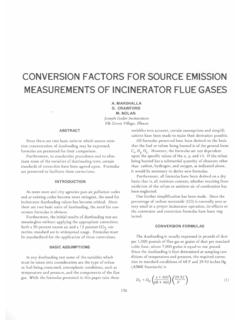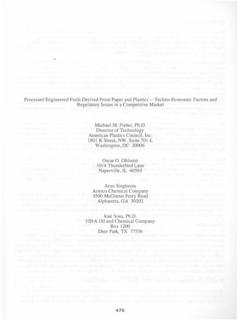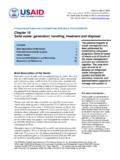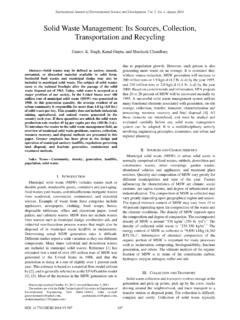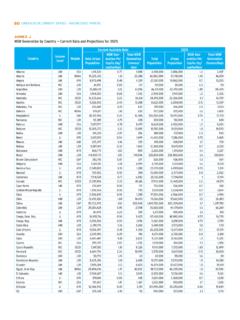Transcription of Design of a Materials Recovery Facility (MRF) For ...
1 Design of a Materials Recovery Facility (MRF) For Processing the Recyclable Materials of New York City s municipal solid Waste by Alexander J. Dubanowitz Advisor: Prof. Nickolas J. Themelis Submitted in partial fulfillment of the requirements for the degree of Master of Science in Earth Resources Engineering Department of Earth and Environmental Engineering Fu Foundation School of Engineering and Applied Science Columbia University May 2000 Design of a Materials Recovery Facility (MRF) For Processing the Recyclable Materials of New York City s municipal solid Waste Alexander J. Dubanowitz EXECUTIVE SUMMARY The closure of Freshkills Landfill in Staten Island at the end of 2001 has forced the City of New York to seek alternative methods of waste management. To begin its waste diversion, the city has resorted to exporting a portion of its waste to other states. The high costs associated with waste exportation along with dramatic increases in disposal tipping fees in recent years has compelled New York City to explore potential alternative waste management options.
2 Increased recycling provides an attractive option since it eliminates some disposal requirements with the additional benefits of reducing pollution, conserving energy, creating jobs and building more competitive manufacturing industries. In addition, through the utilization of a well-designed Materials Recovery Facility and collection system, recycling can be a very economical waste management opportunity. A Materials Recovery Facility (MRF) is a place where solid wastes are delivered to be separated, processed and stored for later use as raw Materials for remanufacturing and reprocessing. In the summer of 1999, the Bureau of Waste Prevention, Reuse and Recycling of the Department of Sanitation (DOS) sponsored an investigation of the technical and economic aspects of a single, city-owned MRF. The study, described in this report, examined the Design and operation of a 150 tons per hour (876,000 tons per year) Facility that could handle all of New York City s recyclables.
3 The operations within the MRF are designed to be as automated as possible to increase speed of operation, reduce costs and improve Recovery . The proposed MRF would be a more cost-effective alternative compared to the currently utilized waste management system. The MRF would require approximately 16 acres of land and cost approximately $127 per ton of diverted material . This would correspond to nearly $46 million of savings for the city in waste management costs annually. 3 ACKNOWLEDGEMENTS The author and the Department of Earth and Environmental Engineering gratefully acknowledge the financial support of this project by the Bureau of Waste Prevention, Reuse and Recycling of NYC-DOS; and by the Dibner Fund through its support of the Earth Engineering Center of Columbia University. The author would also like to thank the staff of the Bureau and especially Susan Cohen, Deputy Director of the Recycling Unit, for her supervision and advice during the research phase of this He also thanks the Department of Earth and Environmental Engineering of Columbia University, and in particular his advisor, Professor Nickolas Themelis, for contributing resources and academic expertise to this project and help with the preparation of this thesis.
4 Last, but not least, the author thanks his family for their support, patience and encouragement throughout his graduate studies. Alex J. Dubanowitz New York City, May 2000 TABLE OF CONTENTS Section Page 5 1. 6 2. Materials Recovery 7 8 Market 10 Mechanical Vs. Manual 11 Tipping 13 3. Waste 13 4. Unit Processing 16 The Conveyor 16 Ferrous Metals 17 18 Air 18 Non-ferrous Metal 19 Detect and Route 20 Glass 21 Plastic 22 Paper and Carton 23 Size .. 23 Compactors and 24 5. MRF Equipment and 24 MRF 25 Paper 25 Metals, Glass, and Plastics (MGP) .. 26 6. Facility 27 Facility 28 Facility 29 Facility 29 Facility 30 7. 34 36 45 List of Tables Table 1: Source Separated Materials for 9 Table 2: Sample Market 10 Table 3: Manual Sorting Rates and 11 Table 4: Automated Sorting Rates and 12 Table 5: City-Wide Residential Waste and Recyclable 14 Table 6: Facilities Receiving Source Separated Paper and MGP (1994).
5 28 Table 7: Siting Requirements for the 150 TPH 30 Table 8: Market Prices for Selected Recycled 31 Table 9: Market Prices for Various Non-Targeted 32 5 Table 10: Total Annual Collection and Processing Costs for the 150 TPH 33 Table 11: Current Collection and Disposal Costs for 777,633 TPY of 33 Table 12: Revenues (Costs) Derived from the Delivery of MGP in Various 35 Table A1: Capital Costs for 150 TPH 37 Table A2: Annual Operation and Maintenance Costs for 150 TPH 38 Table A3: Annual Collection and Disposal Costs for 150 TPH 38 Table A4: Annual Revenue from the Sale of Recyclables for 150 TPH 39 Table A5: Total Annual Costs for 150 TPH 39 List of Figures Figure 1: Inclined Belt 40 Figure 2: Overhead Belt 40 Figure 3: Disc 41 Figure 4: Trommel 41 Figure 5: Vertical Zig Zag Air Classifier and Rotating Drum 42 Figure 6: Active Pulse Flow Air 42 Figure 7: Rotating Disk 43 Figure 8: System Layout of New York City 150 TPH MRF.
6 44 6 1. Introduction The scheduled closure of Freshkills Landfill in Staten Island at the end of 2001 is forcing the City of New York to explore alternative waste management options to begin overcoming its primary reliance on landfilling for waste disposal. The Department of Sanitation currently collects approximately 13,000 tons of municipal solid waste (MSW) each day from about 8 million residents and non-profit institutions. To begin the transition from solely disposing wastes at Freshkills Landfill, a considerable portion of the waste generated in the Bronx borough is being delivered to transfer stations for exportation to Virginia. The exportation of wastes is a very expensive waste management practice (costing about $80 per ton) and additional exportation appears to be inevitable unless changes are made in the current waste management system. The increased restrictions and costs on disposal options and the community opposition to the transport and landfilling of New York City s waste provides motivation to explore other potentially more cost-effective and environmentally acceptable waste management activities.
7 Today s MSW management systems are highly integrated and include various options in Materials collection, Materials Recovery , composting, combustion and landfilling. A thorough examination of a waste management system should consider factors from the point of waste collection to final disposal. One waste management option involves increasing recycling within the city and thereby decreasing the city s overall disposal needs. By transforming waste Materials into useable resources, recycling represents a method of managing solid waste while reducing pollution, conserving energy, creating jobs and building more competitive manufacturing industries. However, attempts to expand the New York City recycling program in the past have been plagued with opposition, participation and operation problems. In the early 1990's, the city had plans for a $125 million project to build five city-owned facilities in each of the five boroughs. The city-owned facilities would have benefited the city by eliminating the high costs associated with the need to ship Materials at greater distances to obtain better prices 7from private contractors.
8 In addition, the inclusion of modern separation technologies could lower operating costs and improve the quality of processed material , decreasing the overall waste management costs of the city. The first Facility was planned to be built in Staten Island, but was challenged by the private recycling contractors who had additional capacity to process New York City s residential wastes. Due to the strong opposition from the industry, environmentalists and budget administrators, the plan was eventually abandoned. With the ongoing increase in solid waste disposal and transportation costs, there is now a greater incentive than ever before to alter the current waste management systems in New York City and develop more cost effective systems. In the past, when landfill tipping fees were low, recycling was not economically feasible as a waste management practice. However, between 1985 and 1992, the national average landfill tipping fee increased by more than 500 percent in the northeastern region of the United With tipping fees increasing dramatically and an increased reliance on expensive and contentious waste exportation, recycling has become a very economical and proven approach to waste management.
9 The objective of this document is to examine the issues associated with the Design and operation of a Materials Recovery Facility for the City of New York. This includes analyzing available separation and Recovery technologies, designing the ideal system layout, and estimating the costs and siting requirements for the proposed Facility . 2. Materials Recovery Facilities A Materials Recovery Facility (MRF) accepts Materials , whether source separated or mixed, and separates, processes and stores them for later use as raw Materials for remanufacturing and reprocessing. The main function of the MRF is to maximize the quantity of recyclables processed, while producing Materials that will generate the highest possible revenues in the market. MRFs can also function to process wastes into a feedstock for biological conversion or into a fuel source for the production of energy. Although these waste management options of chemical transformation of wastes through combustion in conjunction with energy Recovery and biological transformation in the form of aerobic and anaerobic composting are viable and proven technologies, they are not considered in this study.
10 This paper focuses exclusively on designing the MRF for resource Recovery by means of mechanical Materials separation. 8 The stages involved in designing a MRF system to process commingled recyclables include: 1. Conceptual Design 2. Evaluation of the markets and economics of operation 3. Development and gathering of data necessary for the Design 4. Detailed engineering Design of system 5. Siting Design 6. Procurement of equipment 7. Construction 8. Processing of Materials 9. Marketing Collection The collection system for the recyclables that are delivered to the MRF plays a significant role in determining the Facility Design . The building layout and equipment must be designed to accommodate the processing, movement and storage of the collected Materials with safe external access and internal flow. The manner by which wastes are collected will have considerable effect on the costs and resource utilization of the MRF. Collection options for residential refuse and recyclables include:2 1.

